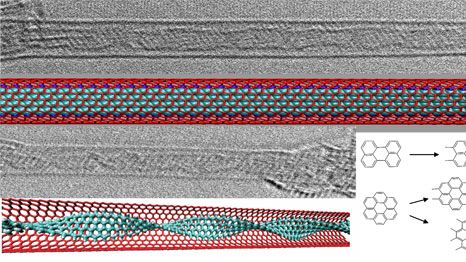
Press release -
New material synthesized: graphene nanoribbons inside of carbon nanotubes
Physicists from Umeå University and Finland have found an efficient way to synthesize graphene nanoribbons directly inside of single-walled carbon nanotubes. The result was recently published in the scientific journal Nano Letters.
Graphene, a one atom thin flake of plain carbon, has a wide range of unusual and highly interesting properties. As a conductor of electricity it performs as well as copper. As a conductor of heat it outperforms all other known materials. There are possibilities to achieve strong variations of the graphene properties by making graphene in the form of belts with various widths, so called nanoribbons. These nanoribbons are now the real focus of attention in physics and an extremely promising material for electronics, solar cells and many other things. However, it is has not been easy to make such ribbons.
Associate professor Alexandr Talyzin and his research group at the Department of Physics, Umeå University, have together with colleagues from Professor Esko Kauppinen´s group, Aalto University in Finland, discovered a way to use the hollow space inside carbon nanotubes as a one-dimensional chemical reactor to make encapsulated graphene. An intriguing property of this space is that chemical reactions occur differently here compared to under bulk three-dimensional conditions.
– We used coronene and perylene, which are large organic molecules, as building blocks to produce long and narrow graphene nanoribbons inside the tubes. The idea of using these molecules as building blocks for graphene synthesis was based on our previous study, says Alexandr Talyzin.
This study revealed that coronene molecules can react with each other at certain conditions to form dimers, trimers and longer molecules in a bulk powder form. The result suggested that coronene molecules can possibly be used for synthesis of graphene but need to be somehow aligned in one plane for the required reaction. The inner space of single-walled carbon nanotubes seemed to be an ideal place to force molecules into the edge-to-edge geometry required for the polymerization reaction.
In the new study, the researchers show that this is possible. When the first samples were observed by electron microscopy by Ilya Anoshkin at Aalto University, exciting results were revealed: all nanotubes were filled inside with graphene nanoribbons.
– The success of the experiments also depended a lot on the choice of nanotubes. Nanotubes of suitable diameter and in high quality were provided by our co-authors from Aalto University, says Alexandr Talyzin.
Later the researchers found that the shape of encapsulated graphene nanoribbons can be modified by using different kinds of aromatic hydrocarbons. The properties of nanoribbons are very different depending on their shape and width. For example, nanoribbons can be either metallic or semiconducting depending on their width and type. Interestingly, carbon nanotubes can also be metallic, semiconducting (depending on their diameter) or insulating when chemically modified.
– This creates an enormous potential for a wide range of applications. We can prepare hybrids that combine graphene and nanotubes in all possible combinations in the future, says Alexandr Talyzin.
For example, metallic nanoribbons inside insulating nanotubes are very thin insulated wires. They might be used directly inside carbon nanotubes to produce light thus making nano-lamps. Semiconducting nanoribbons can possibly be used for transistors or solar cell applications and metallic-metallic combination is in fact a new kind of coaxial nano-cable, macroscopic cables of this kind are used e.g. for transmitting radio signals.
The new method of hybrid synthesis is very simple, easily scalable and allows obtaining almost 100 percent filling of tubes with nanoribbons. The theoretical simulations, performed by Arkady Krasheninnikov in Finland, also show that the graphene nanoribbons keep their unique properties inside the nanotubes while protected from the environment by encapsulation and aligned within bundles of single-walled nanotubes.
– The new material seems very promising, but we have a lot of inter-disciplinary work ahead of us in the field of physics and chemistry. To synthesize the material is just a beginning. Now we want to learn its electric, magnetic and chemical properties and how to use the hybrids for practical applications, says Alexandr Talyzin.
Original publication:
Scientific journal: Nano Letters: Synthesis of graphene nanoribbons encapsulated in single-walled carbon nanotubes. DOI: 10.1021/nl2024678
Authors: A. V. Talyzin , I. V Anoshkin , A. G. Nasibulin , A. Krasheninnikov , R. M. Nieminen , H. Jiang , and E. Kauppinen.
http://pubs.acs.org/doi/pdf/10.1021/nl2024678
Press photographyFigure caption: High resolution TEM images of graphene nanoribbons encapsulated in SWNTs, simulated structures of flat and helical nanoribbons inside of nanotubes and scheme of chemical reaction which results in formation of nanoribbons from coronene and perylene molecules.
For more information, please contact:
Dr. Alexandr Talyzin, Department of Physics, Umeå University
Phone: +49 (0)90-786 63 20
E-mail: alexandr.talyzin@physics.umu.se
